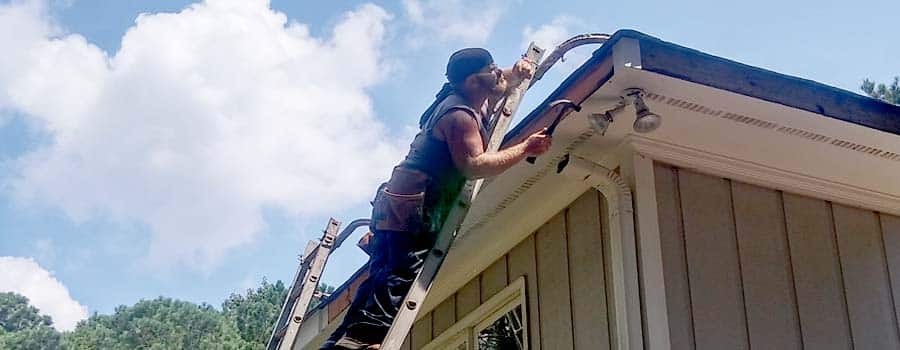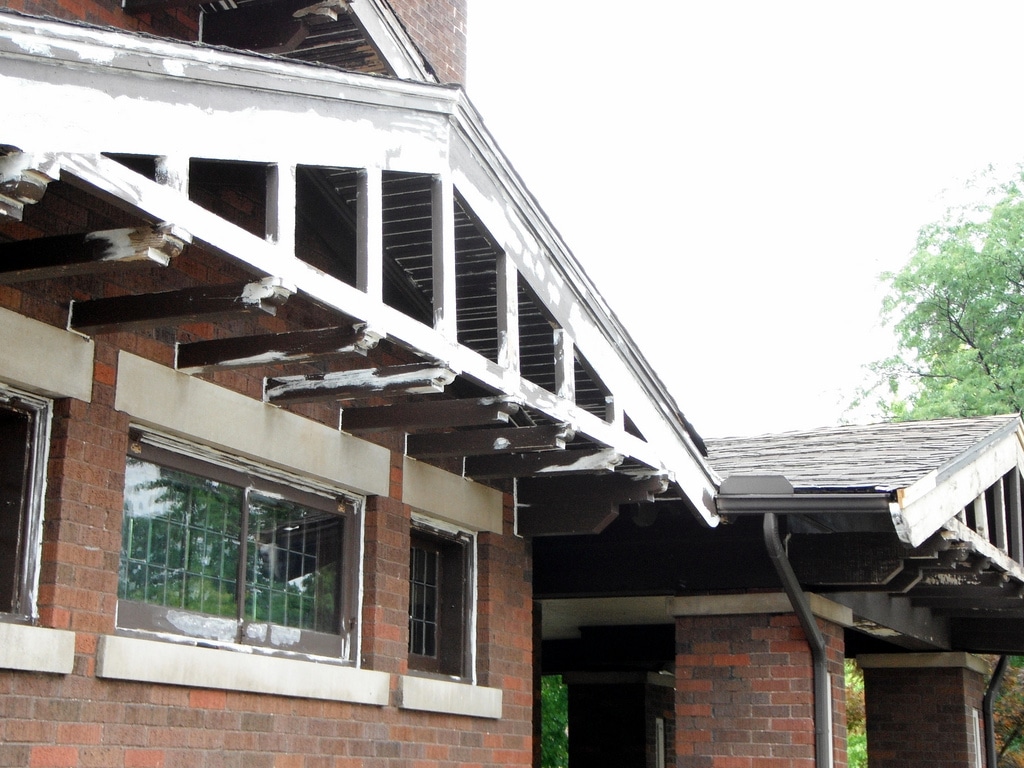
Damaged Fascia Replacement
08/14/2023
Fascia boards are important parts of every roof system. Besides being a supportive part of the lower edge of the bottom row of tiles, fascia boards also hold the rain gutters. That’s why taking care of fascia boards is equally important as taking care of asphalt shingles or other parts of your roof.
In this blog post, we will cover all you need to know about fascia installation and replacement, as well as about soffit board replacement. We’ll also tackle issues regarding fascia repair and the cost of replacement of fascia and soffit in 2023.
If you would like to know more about fascia, soffit, along with their replacement procedures, continue reading. We guarantee your knowledge about these extremely important parts of your house’s roof will be expanded upon!
Why Damaged Fascia Should Be Replaced Before Getting a New Roof
A new roof can easily last 30 or more years, depending on the roof covering or the grade of shingles used, so it makes sense to have a sound substrate under the roof. Any competent roofing contractor will repair damage to the roof deck (usually plywood or OSB sheathing) prior to installing a new roof.
The best roofing contractors will also inspect the structure for damaged fascia boards. Depending on the extent of the damage, a roofing contractor may make the repairs themselves or call in a company that specializes in home repairs.
Some types of damage to the fascia are clearly evident, such as excessive decay, splits in the wood, or woodpecker damage. Other damage may be more difficult to detect. Leaks originating from above the fascia may cause decay that is practically invisible behind a still intact layer of paint. Fascia that is covered by gutters may have damage that is not visible and may be the result of a leaking or overflowing gutter.
The fascia on homes with vinyl siding is often covered with painted or vinyl-coated aluminum trim that may hide damaged fascia behind a pristine facade.
While it’s always a good idea to replace any damaged fascia as soon as possible, it is essential to ensure it’s in good shape before a new roof is installed. Metal eaves drip is an important component in a quality roof installation project. Eaves drip is installed around the perimeter of the roof deck prior to the finished roof, allowing it to extend the overhang of the roof, and providing a barrier against water intrusion above the fascia.
Because eaves drip laps down over and are sometimes nailed to the fascia, it is crucial that it’s in sound condition prior to installing the roof. It is often difficult or impossible to remove damaged fascia boards without damaging or distorting the eaves drip.
Decayed areas in fascia boards are often an indication of a more serious problem. Damaged shingles or a roof puncture, such as from a fallen limb, near the edge of the roof can allow water to seep through the shingles and cause decay of the roof deck, along with the decay of the fascia in the same area. Leaking or improperly installed gutters may allow water to saturate the fascia, causing damage not only to the fascia but the underlying substrate. As any damaged fascia boards are removed, additional wet or decaying areas will also be exposed, allowing the opportunity for a complete repair of the affected areas.
How Often Should Fascia Be Replaced?
One of the questions that pop up quite often is how long the fascia can last before it needs to be replaced or a new one installed.
There are no straightforward answers; namely, it is impossible to give an exact number of years after which the fascia must be replaced. Although there are certain decades-long warranties that you get from the manufacturer when you buy fascia boards and panels, it is more based on predictions since fascia replacement can depend on many factors.
For example, some of these factors could include:
- external factors (weather, climate, etc.),
- the material from which the fascia board is made,
- level of care and maintenance, etc.
External Factors
The rule is simple: if you live in an area that is subject to extreme weather, such as storms, hurricanes, hail, etc., and if you live in an area where rainfall is a frequent occurrence, chances are high that the fascia boards on your roof will not last the guaranteed number of years set by the manufacturer at the time of purchase.
The Material From Which the Fascia Board Is Made
Fascia boards are made of different materials, including wood, PVC, vinyl, aluminum, and even fiber cement. Of course, each of these materials has certain advantages but also disadvantages that can affect the lifespan of the fascia. These disadvantages are mainly related to the durability of a certain material against extreme weather conditions, so it’s necessary to think about an adequate material for the fascia before the actual installation.
Level of Care and Maintenance
Just as other parts of the roof need to be maintained, so does the fascia, and the best maintenance is given through regular roof inspections. This is why it’s important to leave the roof inspection to experienced roofing professionals who will examine your roof in detail, including the condition of your fascia. After the roof inspection, they will present you with a detailed report on the condition of your roof, as well as any potential actions that are needed to keep it functional.
Is It Hard to Replace Fascia Boards?
Rotted fascia is the main reason why fascia boards are getting replaced in the first place. When that happens, there are several steps that need to be taken to make this process go as smoothly as possible. As for the difficulty, replacing fascia boards isn’t demanding, but it still requires removing and uninstalling gutter systems, a lot of cutting with a reciprocating saw, and being equipped with other tools. Therefore, a certain amount of expertise and equipment is required, plus you need to contend with working with heights and ladders, which can cause a certain safety risk that shouldn’t be neglected. We thus recommend that fascia board replacement should be left to professionals.
Fascia Board and Soffit Board Replacement
The soffit is part of your roof structure. It’s located underneath the roof’s eaves and is connected to the fascia. The soffit is important due to the ventilation process and as a protection against squirrels, birds, and other small animals that can enter underneath the roof’s surface.
Since the soffit is located underneath the roof’s eaves and fascia, we need to emphasize that you can’t install a soffit and conduct a soffit replacement UNTIL you remove the fascia boards first. In the end, soffit and fascia replacement cannot go without the other.
2023 Cost to Replace Soffit and Fascia
The installation cost of replacing the soffit and fascia varies from year to year. This inconsistency in price is connected with the price of labor as well as materials, which are prone to different price ranges. Let’s not forget that the size of the roof affects the installation price as well as the complexity of the project itself.
Depending on the previously listed factors, the average fascia and soffit installation costs in 2023 can range anywhere between $1,500 and $5,000.
NOTE: For an exact quote, contact Fortified Roofing, a Cherry Hill residential roofing contractor, so that we can calculate a specific price for your home’s soffit and fascia installation.
Can You Repair Your Fascia?
Unlike full fascia replacement, which includes removing the existing fascia and replacing it with a new fascia board, fascia repair is also possible in some cases. For example, this can include repairing a section of the fascia board, such as a section affected by water damage or severe weather.
Even though fascia repair is possible, it is not recommended, so it is much better to do a full fascia replacement in order to be on the safe side and have this part of the roof of your house fully functional.

Image by Russ on Flickr.com
About the author: Tony Wood is a lifetime resident of North Carolina with over 30 years experience in multiple facets of the industrial, commercial and residential construction industry. For the past 23 years, he has owned and operated Wood’s Home Maintenance Service inc, providing services primarily in Johnston, Wake and Sampson Counties of North Carolina.
